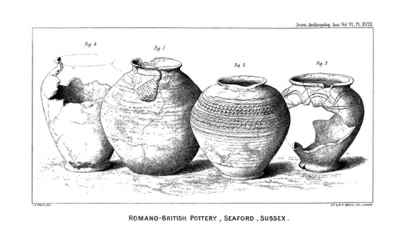To search the RPR site click here
In addition to the artwork in the catalogues of the second collection Pitt-Rivers also used his assistants to prepare artwork for his private publications, Excavations on Cranborne Chase and for his published papers as the following letters make clear:
It seems to me such a pity that your artist should first draw the objects on paper and the lithographer then copy them on stone. It gives just double labour. If your draughtsman cannot work on stone, or on lithographic transfer-paper, why not get him to draw what you want as line drawings on paper, and then have them transferred to a wooden block by one of the photographic processes.
This is a cheaper and more rapid process than lithography; and moreover it has the advantage that the blocks are always in your possession, so that they can be used in any other paper at a future time, whereas if the lithographer copies on to stone he rubs off his work after the interval of a few months and all his labour is lost!
Only your artist must remember that the photographic processes can only reproduce lines, and all shading must be represented in this way. A wash of colour, or a number of lines running indistinctly together, cannot be permitted. The pen if not the brush should be used. [Extract from a letter from F.W. Rudler to Pitt-Rivers dated 16 September 1882, L12 Salisbury and South Wiltshire Museum Pitt-Rivers papers]
Rudler returned to this theme in December of the same year:
... I am inclined to think it will be the best and cheapest way to have Mr Tomkin's pen & ink drawing copied by one of the new photographic processes. It is not so soft as lithography, but then a lithograph is rubbed off the stone after printing and can never be used again, whereas the new processes furnish a metal block which can [sic] used whenever required in the future. [L 49 Rudler to Pitt-Rivers dated 14 December 1882, Salisbury and South Wiltshire Museum Pitt-Rivers papers]
Another intriguing note is enclosed in another letter now at Salisbury and South Wiltshire Museum. In a letter from H.S. Milman dated 27 October 1882 to Pitt-Rivers, Milman says 'In your "Mount Caburn" Plates you have added your name or initials as draughtsman. That point I leave to you, merely mentioning of in case you should have forgotten it.' [in the plates for the paper on 'Caesar's camp' Folkestone]. [L18 Salisbury and South Wiltshire Museum Pitt-Rivers papers]
It is not known exactly what methodology was employed to produce the illustrations in the privately published volumes after 1880, or for his paper publications prior to 1882 (though the latter is likely to be as described by Rudler above).
AP, May 2011.




